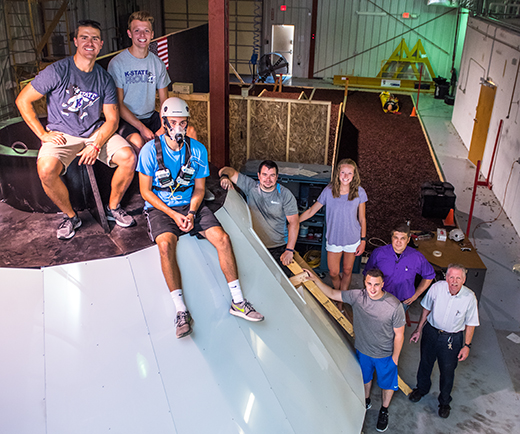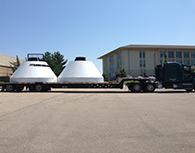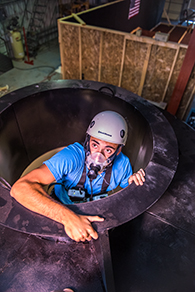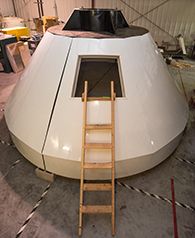The great escape: With mock space capsule, researchers partner with NASA to study astronaut fitness
Tuesday, Sept. 26, 2017
In the style of a home improvement reality TV show, Carl Ade, Kansas State University assistant professor of exercise physiology, discusses the creation of the mock space capsule and the kinesiology research project.
MANHATTAN — A mock space capsule has landed in Kansas State University's Ice Hall. In this built-to-scale model of the Orion spacecraft, "astronauts" practice emergency escape maneuvers while a university kinesiology team studies their health and fitness levels.
It's all part of NASA's plan for further human exploration of the solar system, from a Mars mission to a deep space mission.
The university research team — led by Carl Ade, assistant professor of exercise physiology, and Thomas Barstow, professor of exercise physiology — has partnered with the Johnson Space Center in Houston to tackle a major challenge for these long-duration space missions: the return to earth.
"Maintaining astronaut health is critical to NASA missions, and we need to be able to keep astronauts safe in flight and during landing," said Ade, who has previously studied astronaut health. "By knowing fitness and health standards, we can determine types of in-flight interventions to keep astronauts healthy on long-duration missions that can last several years."
Ade and Barstow are using a two-year NASA grant to study the strength, cardiovascular health and aerobic capacity that astronauts need for an end-of-mission landing or an emergency escape.
That's where the model Orion spacecraft fits in. After a deep space mission, the Orion spacecraft will land in the ocean and astronauts must perform a quick emergency escape. Astronauts must get out of their chairs, climb a ladder out of the capsule and get into a life raft — all difficult tasks after several months in zero-gravity environments. Microgravity is tough on astronauts' bodies and can deteriorate skeleton, muscle and cardiovascular systems.
There's an added challenge: Astronauts must do all of these tasks while inside a capsule that is rocking on the waves of an ocean. All in all, it creates a jolting return to earth.
"We want to determine if astronauts need to reserve a certain level of strength or cardiovascular capacity during flight so that they can land safely after a one- or two-year mission," Ade said. "The model capsule lets us test that in a way that is translatable and allows NASA to apply it directly to future missions."
Ade and the team are studying research participants as they perform the same tasks in the model capsule as astronauts would during an emergency escape. Participants wear special equipment that takes physiological measurements — such as muscle activity, oxygen uptake, heart rate and blood pressure — to determine what kind of stress the body experiences during an emergency escape.
The mock-up Orion capsule is constructed to the exact dimensions as the real version. The research team traveled to Johnson Space Center to make measurements, look at blueprints and develop a way to create the space capsule in Kansas. Local manufacturing companies helped with the design and frame. Once the capsule frame arrived at the Manhattan campus, the research team — including graduate and undergraduate students — finished the construction.
"We have a great group of graduate and undergraduate students who have come together and helped us with all aspects of this project, from construction to testing," Barstow said.
The project can help the general population as well. During deep space missions, astronauts must maintain their physical and cardiovascular capacity in a confined space with few medical resources. If the researchers can find possible interventions with these restrictions, they could apply the same methods to clinical patients or possibly geographic areas without access to medical facilities and resources.
"If we can figure out how to keep an astronaut healthy in this extreme environment, we can translate that to life on earth," Ade said. "This research is really helping both individuals: the astronaut and those here on Earth."
The research is a continuation of nearly 10 years of NASA-funded research to improve astronaut health and determine fitness standards.
"Our goal is to provide information on how fit an astronaut needs to be when they leave so that when they get to the destination or when they return to earth, they will be strong enough to perform mission tasks, even after several months in a zero-gravity environment," Barstow said.
Several Kansas State University undergraduate and graduate students are involved in the research:
Joseph Hammer, sophomore in chemistry, Cherryvale; Dryden Baumfalk, master's student in kinesiology, and Karly Kriss, senior in kinesiology, both from Colby; Macy Mock, junior in kinesiology and pre-occupational therapy, Dodge City.
From Greater Kansas City: Laura Karanevich, sophomore in animal sciences and industry, Lenexa; Riley Hardage, sophomore in nutrition and kinesiology and pre-medicine, Olathe; Adriana Athon, sophomore in open option and pre-occupational therapy, Overland Park; and McKenzie Schmitt, senior in life sciences and pre-medicine, Shawnee.
From Manhattan: Jacob Caldwell, doctoral candidate in kinesiology; Alex Dzewaltowski, senior in mechanical engineering; Shane Hammer, doctoral student in kinesiology; and Hunter Post, master's student in kinesiology.
Connor Nace, master's student in kinesiology, Minneapolis; Kali Pitcock, junior in kinesiology, Russell; Garret Lovoy, senior in nutrition and kinesiology, Topeka; and Andrew Alexander, master's student in kinesiology, Ulysses.
From out of state:
Chris Orme, 2017 graduate in kinesiology, Chula Vista, California; Elena D'Angelo, junior in kinesiology, Broomfield, Colorado; Heather Banister, master's student in kinesiology, Grand Junction, Colorado; Shelbi Sutterfield, master's student in kinesiology, Glenpool, Oklahoma; Charles Schneider, 2017 graduate in kinesiology, Mustang, Oklahoma; Kaylin Didier, doctoral student in kinesiology, Thomas, Oklahoma; and Andrew Stevens, master's student in kinesiology, Ashburn, Virginia.




